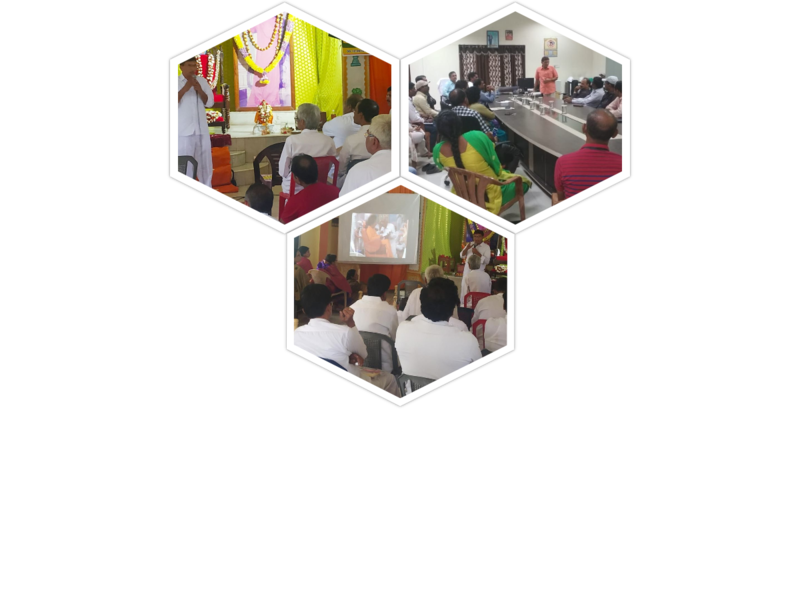In Addition
Vol 11 अंक 1
January/February 2020
1. Health Tips
Befriend Dry fruits for health and energy
“Eat in moderation and live long…Those who know that physical health is the greatest treasure take great care to eat only satvic food. Uncooked food, nuts and fruits, germinating pulses are the best. Use these at least at one meal, say, for the dinner at night; this will ensure long life. And, a long life is to be striven for in order that the years may be utilised for serving one’s fellow beings…” Sri Sathya Sai Baba1
1. What is a dry fruit?
It is a fruit in which the pericarp, which is the wall of the fruit, is not pulpy. Dry fruits include dried fruits and nuts which are biologically same, with two major technical differences. Every fruit seed has the potential to be a plant, which is not possible with nuts. Fruits have juice which nuts lack.2
What is a dried fruit? A fleshy fruit shrinks when most of its water content is removed by sun-drying or using a dryer or de-hydrator, leaving a small energy-dense dried fruit. All dried fruits are sweet in taste, retain most of their nutritional content, and have a long shelf life. Raisins (dried grapes), dates, prunes (dried plums), figs, and apricots are traditional dried fruits which are popular, followed by dried peaches, apples, and pears. Cranberries, blueberries, cherries, strawberries, and mango are infused with a sweetener prior to drying, whereas, dried papaya, kiwi, and pineapple are often candied fruits.3
What is a nut? A nut is a dry fruit filled with only one seed, occasionally two. Nuts are almonds, walnuts, cashew nuts, pistachios, Brazil nuts, hazelnuts, chestnuts, acorns, pecans, pine nuts, and macadamias. Peanuts are actually legumes, like lentils and peas, though referred as nuts due to their similar nutrition profile. 2,4
2. Benefits of dried fruits
General: Delicious and highly nutritious, equivalent to fresh fruits but in a condensed form concentrating all their sugar and calorie content, they give a feeling of fullness on eating. By weight, a dried fruit contains up to 3.5 times the fibre, vitamins, and minerals of a fresh fruit. All dried fruits are a great source of phenolic antioxidants which improve blood flow, boost immunity, better digestive health, decrease oxidative damage, promote brain health, are anti-aging, bone and skin-friendly, and reduce the risk of many diseases including cancer.5,6
Specific benefits of dried fruits
Raisins (59% sugar): Provide valuable nutrients, especially for children, including vitamin C, calcium, iron, potassium, and plant compounds. They do not stick to the teeth long enough and may clear other types of food particles trapped on the teeth and thus protect against dental cavities. They lower BP and blood cholesterol, decrease inflammation, and improve blood sugar level reducing the risk of type-2 diabetes and heart disease.5,7,8
Dates (64-66% sugar): Extremely sweet but may not cause major spikes in blood sugar level due to its low glycaemic index. Ideal for pregnant women due to their mineral and iron content, they can promote cervical dilation minimising the need for induced labour. They are a good source of the trace mineral, selenium, that lowers the risk of bladder and prostate cancer and physiological stress. Also, a remedy for infertility in men.5,9,10
Prunes (38% sugar): Promote healthy vision being rich in beta carotene (which gets converted into vitamin A) & vitamin K; have natural laxative effect due to their high fibre content and sorbitol, and also control an overactive bladder. They are an important source of mineral boron to prevent and fight osteoporosis and a great source of iron to prevent and treat iron deficiency. Being very rich in antioxidants, prunes protect the cells of the body.5,11,12
Caution: Those suffering from ulcerative colitis or allergies may avoid prunes.11
Figs (48% sugar): Loved for their sweetness and mild flavour, they have superior quality of antioxidants; are one of the best sources of vitamins A, C, K & B, and minerals potassium and calcium. Known to alleviate constipation and help in overall diabetes management, good for skin and hair, figs can treat a variety of skin diseases like eczema, vitiligo, and psoriasis.13
Caution: Those allergic to rubber latex or birch pollen or fruits of mulberry family, may also be allergic to figs; those on blood thinning medications may avoid figs due to their high vitamin K content.13
Apricots (53% sugar): Contain many essential vitamins, minerals, and soluble fibre to boost digestion. High in potassium they maintain fluid balance in the body and lower the risk of stroke. They are an excellent source of beta carotene and other carotenoids as well as vitamins A, C, and E, and protect eyes against any damage.14
Dried peaches, apples, and pears: Peaches are delicious and a good source of carbohydrate, protein, and vitamins A & C for boosting the immune system. Dehydrated apples are rich in several B vitamins good for metabolism, liver, and skin; also lend flavour to a range of dishes. Dried pears, rich in vitamin C, E, & B-complex such as folate, are good for overall health.15-17
Other healthier dried fruits: The less common ones like berries, cherries, and pomegranate seeds are considered healthiest. In particular, Goji berries are considered as a modern-day super food, with antibacterial, antifungal, and anti-inflammatory properties. Indian gooseberries (amla) with the highest antioxidants top the list.6
3. Benefits of nuts.
General: High in fat and rich in phenolic antioxidants, vitamins, minerals, and beneficial fibre, nuts are an excellent low carb food. They help in losing weight contrary to the general belief that one may put on weight due to their high calorie content. They prevent lifestyle diseases and support brain function and skin health.21,22
Specific benefits of nuts
Almonds: Rich in healthy fats, fibre, protein, vitamin E, magnesium and manganese, they are considered as prized nuts since ancient times, and most loved. They reduce the bad LDL cholesterol, stabilise blood pressure, and are excellent for gut health as they alkalise the digestive tract and balance the body’s pH.23,24
Walnuts: One of the few nuts that has omega-3 fatty acid to prevent and fight cancer, amino acids to keep the heart healthy, nutrients to prevent age-related brain disorders, and beneficial fat to improve metabolic parameters in type-2 diabetes. 90% of antioxidants are in their skin and, being easily perishable, should be stored in air tight containers.25-27
Caution: Those with herpes should limit or avoid them till fully cured.25
Cashew nuts: Apart from the nutritive features of nuts in general, they contain a powerful antioxidant pigment, zeaxanthin, which is directly absorbed by the retina, preventing age-related macular degeneration and thereby maintaining eye health. Cashews help in keeping the hair healthy and shiny.28,29
Pistachios: Highly nutritious in their natural form with all the health benefits of nuts, they have a unique slightly sweet flavour. Have the highest content of zeaxanthin and lutein among nuts, excellent for eyes and the heart; also promote gut health and reduce the risk of colon cancer.30,31
Brazil nuts: Smooth in texture, with a sweet and earthy flavour, this nut is a staple diet of the natives in Amazon forest. Just one Brazil nut provides 100% of the daily needed selenium, an essential trace mineral vital for body metabolism and important for cognitive function, healthy immune system, healthy shiny hair, and fertility in both men and women. This nut gives a natural glow to the skin and prevents acne, ageing, and skin cancer.32
Hazelnuts: Having a sweet flavour they can be eaten raw. High in calories, they are a rich source of mono and polyunsaturated fats and omega-6 and omega-9 fatty acids. The antioxidants are concentrated in their skin which make them ideal to be consumed whole, unpeeled and unroasted. In ancient times, they were used as a medicine and tonic. Hazelnut is commonly used for flavouring coffee and pastries and for topping and garnishing desserts.33,34,35
Chestnuts: Highly nutritive with a low glycaemic index, they are excellent for health. Roasted ones are popular, but are commonly candied, boiled, steamed, or made into bread. They boost the immune system, increase bone mineral density, improve brain function, relieve digestive issues, control BP, and prevent chronic illnesses.36
Acorns (nuts from oak tree): Rich in vitamins, especially B1 to B9, and many minerals, acorns improve digestion, boost energy levels, keep bones healthy, and lower the risk of heart disease, diabetes, and cancer. But they are bitter in taste and tough to metabolize because of their tannin content. So, to make them eatable, boil or soak until they stop turning the water brown. The water can be applied on the skin to reduce inflammation, soothe burns and rashes, and heal cuts and wounds. The most nutritious way to consume acorns is to make coffee out of it as one would make from coffee beans. Acorns coffee would be 100% caffeine free!37,38
Pecans (related to the walnut), Pine nuts, and Macadamias have all the nutritive characteristics of nuts, with a buttery flavour.39-41
General Caution: If anyone is allergic to any nuts, it is best to avoid them or limit the quantity intake to bare minimum.
4. Moderation is the key to good health
Inclusive diet: Fresh fruits generally contain more vitamins and minerals than dried ones as the drying process can destroy water-soluble vitamins B’s and C. Nevertheless, dried fruits surpass fresh fruits in fibre and antioxidant content and should be an important part of our diet. Their intake will gradually reduce the need for fats and sugar in food ensuring proper metabolism. Inclusion of dried fruits and nuts in diet is known to have helped sportspersons to enhance their performance.6,18,19,42
Moderate quantity: Healthier than processed or junk food, most of the dried fruits are high in sugar content and calories, especially those infused with sweeteners or candied. Therefore, they should be taken in moderation to stay fit. One serving, that is, a quarter cup or one handful (30 g) of dried fruits is equivalent to 1 cup of juicy fresh fruit and adequate to provide the needed folate. Similarly, one fistful (30 g) of nuts per day should suffice. If affordable and practicable, every day one variety of both dried fruits and nuts may be taken and their effect observed over a period of time to know the requirements of one’s body.5,6
Best time for dried fruits: Best time is morning or during the day, preferably along with other nutritious foods. Dried fruits can be included in a baby’s diet from 7-9 months of age after observing their effect on the baby for 2-3 days.20
Best time for nuts is whenever one is hungry or tired, as a healthy snack or with salad or soup. However, it is best to take nuts in the morning hours along with breakfast; it helps to stay energetic the whole day and to ward off fatigue. Soaking them in water overnight would free them from anti-nutrients and make them easily digestible and absorbable, especially almonds and walnuts. Sai Baba has advised students to take overnight soaked 2-3 almonds every morning, after removing its skin. Avoid cashew nuts at night as they may be heavy on the stomach and disturb sleep. Also avoid oil roasted and chocolate coated nuts.43,44
Caution: Being nutritionally dense, it is easy to consume dry fruits in excess; this may lead to weight gain, indigestion, and other health problems. So, watch out as the body will tell you how much to eat.19
References and Links:
- Sathya Sai Speaks, Volume 15, Chapter 21, Divine Discourse on Good Health and Goodness, 30 September 1981; www.sssbpt.info/English/sssvol15.html
- https://www.quora.com/What-is-the-difference-between-nuts-and-dry-fruits
- https://en.wikipedia.org/wiki/Dried_fruit
- https://www.bodyandsoul.com.au/nutrition/almonds-walnuts-cashews-get-to-know-your-nuts/news-story/e9d80be322939d514fdb6519b5e82ba5
- General benefits of dried fruits: https://www.healthline.com/nutrition/dried-fruit-good-or-bad
- Moderation, Caution & Care: https://heartmdinstitute.com/diet-nutrition/dried-fruit-healthy-sugar-bomb/
- Raisins: https://www.newswise.com/articles/new-raisin-research-shows-several-health-benefits
- https://www.healthline.com/health/food-nutrition/are-raisins-good-for-you
- Dates: https://www.healthline.com/nutrition/benefits-of-dates
- https://nuts.com/healthy-eating/benefits-of-dates
- Prunes: https://www.healthline.com/health/food-nutrition/top-benefits-of-prunes-prune-juice#iron
- https://food.ndtv.com/health/7-amazing-prunes-benefits-1404766
- Figs: https://www.healthline.com/health/figs
- Apricots: https://www.healthline.com/nutrition/apricots-benefits
- Dried Peaches: https://nuts.com/driedfruit/peaches/jumbo.html
- Dehydrated Apples: https://healthyeating.sfgate.com/dehydrated-apples-healthy-5756.html
- Dried Pears: https://nuts.com/driedfruit/pears/premium.html
- Diet: https://www.ncbi.nlm.nih.gov/pubmed/15670984
- https://www.health.harvard.edu/healthy-eating/is-eating-dried-fruit-healthy
- https://parenting.firstcry.com/articles/dry-fruits-for-babies-when-to-introduce-and-health-benefits/
- Benefits of Nuts: https://www.healthline.com/nutrition/8-benefits-of-nuts#section1
- https://www.healthline.com/nutrition/9-healthy-nuts#section2
- Almonds: https://draxe.com/nutrition/almonds-nutrition/
- https://www.healthline.com/nutrition/9-proven-benefits-of-almonds
- Walnuts: https://www.healthline.com/nutrition/benefits-of-walnuts#section5
- https://articles.mercola.com/sites/articles/archive/2014/05/19/7-walnuts-benefits.aspx
- https://www.nutritionfitnesscentral.com/proven-benefits-walnuts/
- Cashew nuts: https://www.healthline.com/health/are-cashews-good-for-you#takeaway
- https://food.ndtv.com/food-drinks/7-incredible-cashew-nut-benefits-from-heart-health-to-gorgeous-hair-1415221
- Pistachios: https://www.medicalnewstoday.com/articles/322899.php#myths-about-pistachios
- https://www.healthline.com/nutrition/9-benefits-of-pistachios#1
- Brazil nuts: https://www.healthbeckon.com/brazil-nuts-benefits
- Hazelnuts: https://www.organicfacts.net/health-benefits/seed-and-nut/hazelnuts.html
- https://draxe.com/nutrition/hazelnuts/
- https://www.healthline.com/nutrition/hazelnut-benefits#section1
- Chestnuts: https://www.organicfacts.net/health-benefits/seed-and-nut/chestnuts.html
- Acorns: https://www.healthline.com/nutrition/can-you-eat-acorns#downsides
- https://www.organicfacts.net/health-benefits/seed-and-nut/acorns.html
- Pecans: https://food.ndtv.com/food-drinks/why-pecan-nuts-are-good-for-you-and-how-to-eat-them-1262183
- Pine nuts: https://food.ndtv.com/food-drinks/8-health-benefits-of-pine-nuts-chilgoza-the-nutty-winter-treat-1621360
- Macadamias: https://www.healthline.com/nutrition/9-healthy-nuts#section11
- https://omigy.com/fruits/dried-fruit-health-benefits/
- https://food.ndtv.com/food-drinks/what-is-the-best-time-to-consume-nuts-we-find-out-1749282
- Eat almonds: https://sathyasaiwithstudents.blogspot.com/2012/11/do-you-eat-almonds.html#.Xgoz4i2B3nU
2. AVP workshop & Refresher, Puttaparthi, India, 16-22 November 2019
This intense one-week workshop was attended by eight participants, both from India and abroad. The French coordinator and two other SVPs came as observers and assisted the new candidates. The highly interactive case-study-based workshop was planned and conducted by two senior teachers 10375 & 11422, supported by founder faculty member Hem Aggarwal who gave valuable inputs on each category from 108CC book and effective case history writing. The workshop provided practical training to the participants through a live clinic as well as demos and role playing by teachers, participants, and other senior practitioners. Dr Jit Aggarwal shared his journey in vibrionics, his memorable interactions with Swami, and lessons learnt directly from Him. He gave invaluable guidance on practising Love & Gratitude accepting everything that comes our way as Gift of God, and the way to be an ideal practitioner. All the qualified AVPs took their oath with solemnity and sincerity, seeking the blessings of Swami.

3. SVP workshop, Puttaparthi, India, 24-28 November 2019
Four candidates from India and abroad qualified as SVPs after a 5-day intense workshop conducted by the same faculty members00006,10375 & 11422. French teacher and coordinator from France01620 and three other senior practitioners attended as observers to refresh their knowledge and assisted where required. Practitioner 03589 from France translated for a non-English speaking candidate throughout the workshop. In his address Dr Jit Aggarwal outlined the commitment expected of an SVP, importance of following the middle path in life, especially in lifestyle, and the significance of “forgive and forget” principle for one’s own spiritual evolution and the technique to do it. The qualified candidates took oath before Swami and received their SRHVP machines with humility and resolved to do their best in Sai seva.

4. Vibrionics awareness camps in Bhadradri, Telangana, India, 8 &17 December 2019
On 8 December, at a well-attended State level meeting of Sri Sathya Sai organisation of Telangana at Bhadrachalam, our senior practitioner11585 gave a talk with PowerPoint presentation, about how Swami had blessed Vibrionics as the medicine of the future, how it works, and some successful case histories. 21 out of 50 participants got inspired and came forward to take remedies at the vibrionics camp organised during lunch break.
He also held an awareness camp on 17 December at Bhadradri thermal power station, attended by the engineers working there. After listening to his inspiring talk, a total of 17 participants took vibrionics treatment.
In both the camps, he also talked about the admission process and those who expressed interest in learning vibrionics were given guidance.

